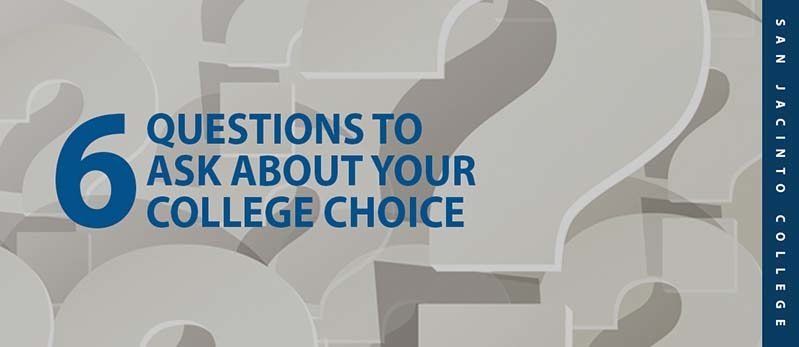
By Naomi Sheehan and Amanda Fenwick
In an era of high college costs, long-term student debt, and an uncertain job market, students and parents are compelled to consider a college degree as a serious investment. Measures like price, debt, and post-graduation employability and pay outlook must all be weighed in deciding on the quality of a school.
How can you make a wise choice? Posing the following questions can help you chart your educational course.
- 1. What are the costs?
Cost is a — if not the — prime consideration for most students and their families.
San Jacinto College is committed to keeping tuition affordable for students and taxpayers. San Jacinto College tuition is about one-third of the cost of public four-year colleges and universities in Texas, and is offers one of the lowest tuitions in the Gulf Coast Region.
| Tuition and Fee Comparison | |||||
| Based on 15 semester credit hours for both the fall and spring semesters FY 2017-2018 |
|||||
| University | Resident | Community College | In District | Out of District | |
| UH – Downtown | $7,451 | College of the Mainland | $1,773 | $2,973 | |
| UH-Clear Lake | $8,188 | San Jacinto College | $1,860 | $3,210 | |
| Texas Southern | $9,162 | Lone Star College | $1,926 | $4,086 | |
| Stephen F. Austin | $9,538 | Alvin Community College | $1,940 | $3,320 | |
| Texas A&M | $9,882 | Houston Community College | $2,031 | $4,191 | |
| Sam Houston State | $9,890 | Galveston College | $2,050 | $2,650 | |
| UT Austin | $10,092 | Lee College | $2,194 | $3,394 | |
| Texas A&M Galveston | $10,540 | Brazosport College | $2,715 | $3,525 | |
| University of Houston | $11,078 | Wharton Junior College | $3,110 | $4,640 | |
| Average | $ 9,536 | Average | $2,178 | $3,554 | |
- 2. What programs are offered?
Community colleges offer dozens of certificate and associate degree programs, including some that lead to a bachelor’s degree or higher credential through a transfer track, as well as short-term certificates taking a matter of months to complete.
These range from industrial and technical, medical and STEM-focused, socially oriented criminal justice and education degree options, to traditional humanities and sciences programs.
- 3. What are the economic outcomes for graduates?
Most students are rightly concerned about landing a job after earning a degree. Are the skills you learned in college applicable in the workforce? Or to put it another way, does a college live up to its claims in terms of providing a better future for its students?
While community colleges are sensitive to local economic shifts and the needs of industry in their service areas and tailor their courses accordingly, most four-years and for-profits are less responsive. Community colleges frequently forge partnerships with local industry to help their students get cutting edge skills and get into the career pipeline.
Resources
Compare and rank schools: collegescorecard.ed.gov
Net price calculator: collegecost.ed.gov/netpricecenter.aspx
Apply for financial aid: fafsa.ed.gov, San Jacinto College code is: 003609
Contact San Jacinto College: 281-998-6150
- 4. How much debt will I take on?
Because of the low price of community college coupled with financial aid, many students graduate with little to no debt. For the 2016-17 school year, the maximum Federal Pell Grant is $5,815. This often leaves money for books and other needs. The College Board reports community college students in 2015-16 had an average $770 left over after financial aid.
This is perhaps the “best kept secret” of community colleges — unfortunately for students who enroll in for-profit schools and wind up saddled with huge debt loads and damaged credit ratings.
While for-profit schools account for about 8 percent of the total higher education student population, these students make up a whopping 44 percent of federal student loan defaults. Starting at a community college can mean avoiding a lifetime of financial headaches.
- 5. Will my credits transfer?
Most community colleges, including San Jacinto College, have “articulation agreements” with two- and four-year schools, and educational planners will help you plan your transfer in advance.
Articulation agreements ensure you don’t waste time or money earning your bachelor’s degree, and set you on the path to success.
- 6. What resources does the school provide to help me succeed?
Community colleges place a premium on helping students complete their goals, even when life is complicated by work and family obligations. San Jacinto College offers flexible class schedules, weekend courses, and online class options that work around your schedule.
Student success often comes down to the resources a college can provide outside of the classroom. Financial advising, career placement, tutoring, and other student services are vital for navigating higher education. San Jacinto College offers a support system to students.
